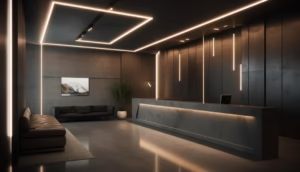Led lighting always comes at the forefront of the discussion when it comes to the topic on sustainability and energy efficiency in an ever growing environmentally conscious world. Although some are so rude as to dare call LED lighting trash, a closer look reveals a bounty of benefits that this new technology brings. A benefit to help us all, a little green in the world of lighting, without burning too hot — LED creates less waste and increases the overall quality so that we can harness light.
The Surprising Benefits of Using LED Lighting
One of the main critiques against LED lights is their initial cost and the leading assumption that LED lighting is of low quality. But such views tend to ignore the long-term savings potential and how far the technology has come making LEDs comparable to legacy lighting in performance. LED lighting has many advantages; here are some of them:
- Energy Efficiency: LEDs use up to 90% less electricity than filament lamps. This drastic reduction in energy consumption results in significant savings for both households and businesses. Ultimately, the upfront cost of LEDs pays for itself several times over via reduced utility bills.
- Lifespan: LED bulbs outlive traditional light emitters by several folds. Whereas a somewhat-dim incandescent bulb might burn for 1,000 hours, an LED can burn for as long as 50,000 hours. The longer life reduces the need for frequent replacements, providing savings in both money and people hours.
- Durability: While incandescent and fluorescent bulbs rely on fragile elements like filaments and glass, LEDs are constructed with heavy-duty materials that can handle tough conditions and rough treatment. This makes them well-suited for use in spaces where other types of lighting may be susceptible to damage.
- Environmentally Friendly: LEDs do not contain hazardous waste (such as mercury found in fluorescent light). That makes them safer as they have less impact on the environment and toxic waste. Most of their electricity use comes from generating power, so their lower power consumption means less greenhouse gas emissions from power plants.
- Design flexibility — LEDs have a small footprint which enables new designs. Traditional lighting would be impractical for some uses where LEDs can be deployed — for example, in tight spaces and in artistic lighting that enhances aesthetic appeal.
- Enhanced Light Quality: Newer LEDs provide incredible color fidelity and brightness, adjustable to create a mood or match a setting. Technology has come a long way since then, as issues like the “cold” light that early LEDs emitted have been all but solved, leaving the modern LED light far warmer and more inviting.
The statement “LED lighting is trash” may get a few clicks, but fails to acknowledge the myriad of improvements and advantages related to LED technology. Let us pave a road to this sustainable energy and with this shift in mind the most effective tool will be energy saving devices and lights. From Atlantic City to the cool warmth of our homes, LEDs lessen the environmental and energy load while lighting and enhancing our world like never before.




